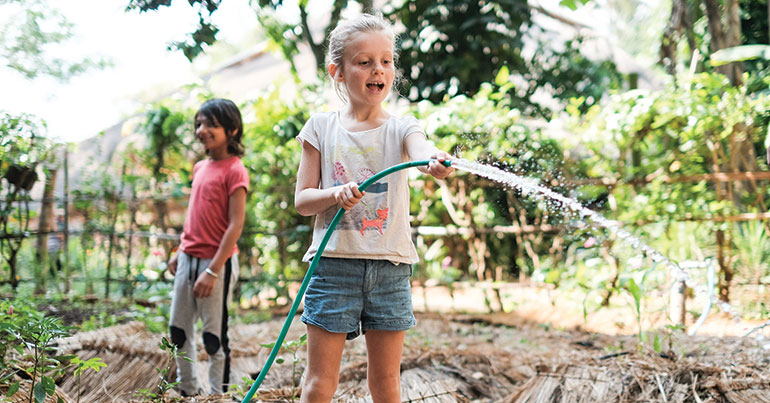Excitement is in the air as students clad in green shirts walk along paths under canopied trees between classes. A young four-piece band is setting up its equipment on the playing field, and an employee is adding an additional row of cinderblock seats around the U-shaped bamboo-latticed assembly hall.
“The community is coming together from pre-K to high school,” said Kate Druhan, Green School’s chair of board of management – and a parent of several of its students. She spoke with Southeast Asia Globe on the day of the school’s tenth-anniversary celebrations. More than 600 students, faculty and members of the surrounding community gathered for singing, dancing, a look back at the school’s first decade through video and memorabilia, the unveiling of a new school logo – and a mountain of rice with delectable-looking side dishes and a three-tiered cake.
“I hope it doesn’t rain, but if it does, we’re going to celebrate with mud, I’m sure,” Druhan added.
John and Cynthia Hardy opened the innovative and unusual school in a jungle in Bali after reading the “Three Springs” manifesto by education theorist Alan Wagstaff. Wagstaff envisioned a learning village with three facets: educational, social and commercial, all holistic and student-centred. Although its student body has grown in size six times over (now including 43 Balinese students) since its founding and its curriculum has evolved, Green School’s foundation has remained the same.
“The learning programme, the learning environment and learning community are the three tenets of what is Green School. Those are the magic ingredients,” said Lee Ann McKee, director of marketing and communications for Green School – and also a parent of one student.
Leslie Medema, the head of learning programmes, has observed the school’s evolution over her eight years there. “The [‘Three Springs’] document provides a philosophical foundation for all that we do, but the specifics of that document have obviously changed in many ways, and that’s what’s been really interesting about the journey we’ve been on… We have really built the program – and what has become our identity – from the ground up.”
She offered an analogy of the school being like a 10-year-old child: “They have lots of opinions, they know who they are, they have personality and they have an identity. And that’s very true of us – but at the same time, they’re reforming and continuing to grow and to mature.”
The Green School curriculum is an amalgamation of curricula from around the world, including Finland, Nova Scotia, New Zealand, Australia, Cambridge – “and we have pedagogical principles that are really important to guide this,” added Medema. “As you look at developing even a single lesson, you look at if it’s relationship-centred, it’s experiential… But we also realise that it doesn’t have to be that way. There are no musts at Green School.”
Another important aspect of Green School’s pedagogy is the incorporation of environmentalism, entrepreneurship and the creative arts. This can be seen through their wall-less classrooms, the student project bank, by which students can take out loans to start a project on campus, and integrated classes that cover art, maths and physics to teach students how to build a bamboo bicycle, for example.

“It’s about the balance of learning,” explained Medema. “Is it authentic? How authentic can it be? Can we tie it to real-world examples? If a young student in particular can make a difference in their community now, reducing the paper that we use, and they feel that empowerment, they’re much more likely to develop those mindsets [of environmentalism and entrepreneurship]. And locally – let’s connect here first, let’s make an impact here first. We’ll think globally and act locally.”
The school year runs on a six-week block system, and middle and high school students pick different electives every six or 12 weeks to explore subjects that interest them, thus taking ownership of their studies. Teachers pitch course ideas every block to the assembly of students, and there are over 230 courses on offer every year. Students spend their senior year working on a large final project, culminating in a university thesis-type presentation.
“It’s very self-directed. Kids are not pushed to do stuff,” said McKee. “They need to do certain things, but it’s more about recognizing their skills and talents and trying to pull out the best of each student.”
Evidence of how the Green School is different from most educational institutions is omnipresent through sights, sounds and smells on a campus tour. The first and most notable sign is that the entire campus is built of bamboo.
The visitor tour starts near a traditional Balinese kitchen and pizza oven fired on bamboo dust, adjacent to the new coworking space designed for parents (many are “cyber nomads”). The tour passes other eateries and a playing field – currently showing a large photography exhibit – and then arrives at the Heart of Campus, an open-air structure made of three towers representing the three pillars of the school. It also serves as the high school, IT centre and library. The air hints of incense as the tour winds past a farm, a composting station, an aquaponics garden, a yoga pavilion (again, more for the parents), a river with a spring-fed swimming pool carved into it, a mud pit for traditional Balinese mud fighting called mepantigan and the art pavilion, where wooden chimes cast a meditative melody.
“We really try to equalise the time that students spend in creative endeavours and the physical endeavours and intellectual and social-emotional,” said Medema. “Traditional education will have you more in the intellectual, academic realm. It’s just proven that you’ll actually perform better in those areas if you’re more physical, if you’re more comfortable with who you are.”
Spending time outdoors and preserving the environment for future generations are actual musts for Green School. Students are not allowed to bring plastic bottles on campus, and all of the school’s water is tapped from an underground spring. The kitchen doesn’t use palm oil because of its destructive origins, and the school collects used cooking oil from establishments around Bali to make biofuel for its school buses (an enterprise started by grade 12 students). All of the food served is locally sourced and organic. There is a hydroponics area where children learn how fish and plants work together to clean the water and feed each other. And local students gain admittance to the Kul Kul Connection English-language afterschool program by bringing two kilos of trash every semester.
Of course, any learning institution can’t function with just a cool-looking campus, sound environmental practices and a community working together to maintain it. There is a steep tuition fee for international students, who make up the vast majority of the student body, of between $13,000 and $18,000 per year. The tuition is virtually free for local students, though the school has a thorough admission evaluation to make sure Balinese students are prepared for the potential culture shock of unorthodox teaching methods and of meeting people of diverse backgrounds.
Due to the demand of educators globally who have expressed an interest in using the school’s methods, Green School has created the three- to seven-day Green Educator Course to instruct visiting teachers in their holistic, student-centred, nature-based practices and pedagogy.
“Our goal and mantra for the last three years has been to create a sustainable and shareable Green School,” said Druhan. “We know there are others out there in the world who are also doing interesting things in education, and we want to be connected to them. We’re interested in learning, but we’re also interested in sharing what we’re doing.”
The school is currently working on the best way to connect with schools internationally to grow more examples of holistic and environmentally focused campuses.
It’s true, the Green School has an enviable campus located in a beautiful region. But the desire to join the school’s very long waitlist, or to journey to the island to learn its teaching methods, isn’t born of simply wanting to be part of this Shangri-La. The Green School is the embodiment of trends seen elsewhere in society, a desire to regain control over our consumption, environment and education – and make them better.
“We are a grassroots organisation that has built what we’ve needed over time,” said Medema. “But we’ve done it always looking at the best practices in the world.”


